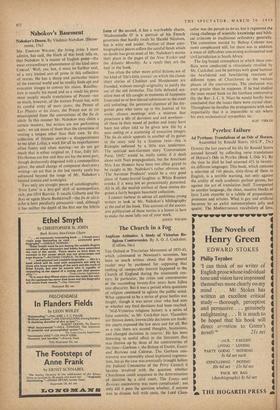The Church in a Fog
Anglican Attitudes: A Study of Victorian Re- ligious Controversies. By A. 0. J. Cockshut„ (Collins, 16s.) TIIE Oxford or Tractarian Movement of 1833-45, which culminated in Newman's secession, has been so much written about that the general reader may be pardoned for supposing that nothing of comparable interest happened in the Church of England during the nineteenth cen- tury. In particular, the crises and controversies of the succeeding twenty-five years have fallen into obscurity. But it was a period when questions of religion continued to agitate the public mind. What appeared to be a series of great battles was fought, though it was never clear who had won or whether any final decisions had been reached.
`Mid-Victorian religious history is a series of false summits,' as Mr. Cockshut says. 'Gauntlets are thrown down, irrevocable decisions are made; the courts expound the law once and for all. But as a rule there are second thoughts, hesitations, and changed decisions in reserve.' He has been browsing to useful effect in the literature that was thrown up by three of the controversies of the time—Gorham v. the Bishop of Exeter, Essays and Reviews and Colenso. The Gorham con- troversy was ostensibly about baptismal regenera- tion, but as the case was eventually brought before the Judicial Committee of the Privy Council it became involved with the question whether Churchmen could acquiesce in the determination of doctrine by a civil court. The Essays and Reviews controversy was more complicated : not Only did it pose the question whether, if anyone was to dismiss hell with costs, the Lord Chan-
cellor was the person to do so, but it registered the rising challenge of scientific knowledge and bibli- cal criticism to traditional orthodoxy generally. The contention started by Bishop Colenso was more complicated still, for there was in addition a maze of difficulties concerning ecclesiastical and civil jurisdiction in South Africa.
The fog-bound atmosphere in which these con- flicts were conducted is vivaciously recalled by Mr. Cockshut, and he portrays with good humour the bewildered and bewildering reactions of different types of Churchmen to the various phases of the controversies. The confusion was even greater than he supposes. If he had studied the most recent book on the Gorham controversy (by the Rev. J. C. S. Nias) he would hardly have concluded that the issues there were crystal clear. Throughout he handles the protagonists with such impartiality that it is impossible to say where his own ecclesiastical sympathies lie.
ALEC VIDLER


































 Previous page
Previous page